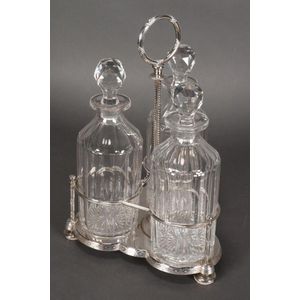Victorian Sterling Silver Tantalus with Crystal Decanters
You must be a subscriber, and be logged in to view price and dealer details.
Subscribe Now to view actual auction price for this item
When you subscribe, you have the option of setting the currency in which to display prices to $Au, $US, $NZ or Stg.
- Tantalus - A tantalus is a container for holding two or three glass or crystal bottles of alchoholic drinks. A tantalus may take various forms, the most common being made from silver, silver plate or wood with the three bottles in a circle or two bottles in line with a central handle. A larger version has three bottles in a line with two end supports and a horizontal top and handle. To prevent unauthorised access, some tantalus have a locking mecahnism that prevents the bottles and stoppers being removed from the bottles when secured.
A box tantalus, as the name implies is an elaborate wooden box made of a fancy timber such as coramandel, with divisions for the bottles and a lockable lid. Some of these type are designed for liquers and include the liquer glasses set into fitted holders. - Victorian Period - The Victorian period of furniture and decorative arts design covers the reign of Queen Victoria from 1837 to 1901. There was not one dominant style of furniture in the Victorian period. Designers used and modified many historical styles such as Gothic, Tudor, Elizabethan, English Rococo, Neoclassical and others, although use of some styles, such as English Rococo and Gothic tended to dominate the furniture manufacture of the period.
The Victorian period was preceded by the Regency and William IV periods, and followed by the Edwardian period, named for Edward VII (1841 ? 1910) who was King of the United Kingdom and the British Dominions and Emperor of India for the brief period from 1901 until his death in 1910. - Gadrooning - A series of lobes usually as a border. In furniture gadrooning is found as carved decoration around the edges of table tops in the Chippendale and Jacobean style furniture. Gadrooning is also found as decoration on the rims of silver and ceramics.
- Sterling Silver - Sterling silver is a mixture of 92.5% pure silver and 7.5% of another metal, usually copper. Fine silver is 99.9% pure silver, and is relatively soft and the addition of the very small amount of copper gives the metal enough strength and hardness to be worked into jewellery, decorative and household objects.
- Faceting - Faceting is a technique of removing material from a curved surface, to give a series of flat surfaces but retaining the profile of the original surface.
The technique is most commonly associated with diamond cutting where the various cuts used such as rose cut and brilliant cut, add life and sparkle to the stone, whilst at the same time removing as little of the stone as possible.
Faceting by grinding is also used to decorate glass. The stems of many drinking glasses are decorated by cutting a series of flat surfaces on a circular stem, and hollow vessels such as vases may have faceted surfaces.
In furniture faceting is often applied to legs of tables and chairs, where a circular baluster shaped section is flattened so as to form an octagonal section. - Engine Turned - Engine turning is a decorative technique used on metal surfaces to create intricate curving or geometric pattern. The process involves cutting a series of lines into the surface of the metal using a rose engine or decoration lathe which rotates the metal as it cuts, allowing the operator to create a repeating pattern that covers the entire surface. The resulting surface has a shimmering, reflective quality that is often described as "engine turned." Where an engine turned item has been enamelled, the term used to describe the decoration is usually guilloche.
Engine turning was originally developed to decorate metal objects such as firearms, scientific instruments, and other metal objects that required precise and elegant design.
This item has been included into following indexes:
Visually similar items

A group of four Scandinavian decanters, contemporary, two rounded rectangular cut Orrefors decanters with squared stoppers, both etch marked underside; one Boda design of squat cylindrical form with round stopper and label attached; the other of compressed

Glass gilt painted perfume bottle together with a glass gilt painted sugar pot with lid

Pair of Swedish decanters, 24 cm high and shorter (2)

A Stuart Crystal decanter, rectangular in shape with cut diamond cuts & a facetted stopper, height 25 cm
